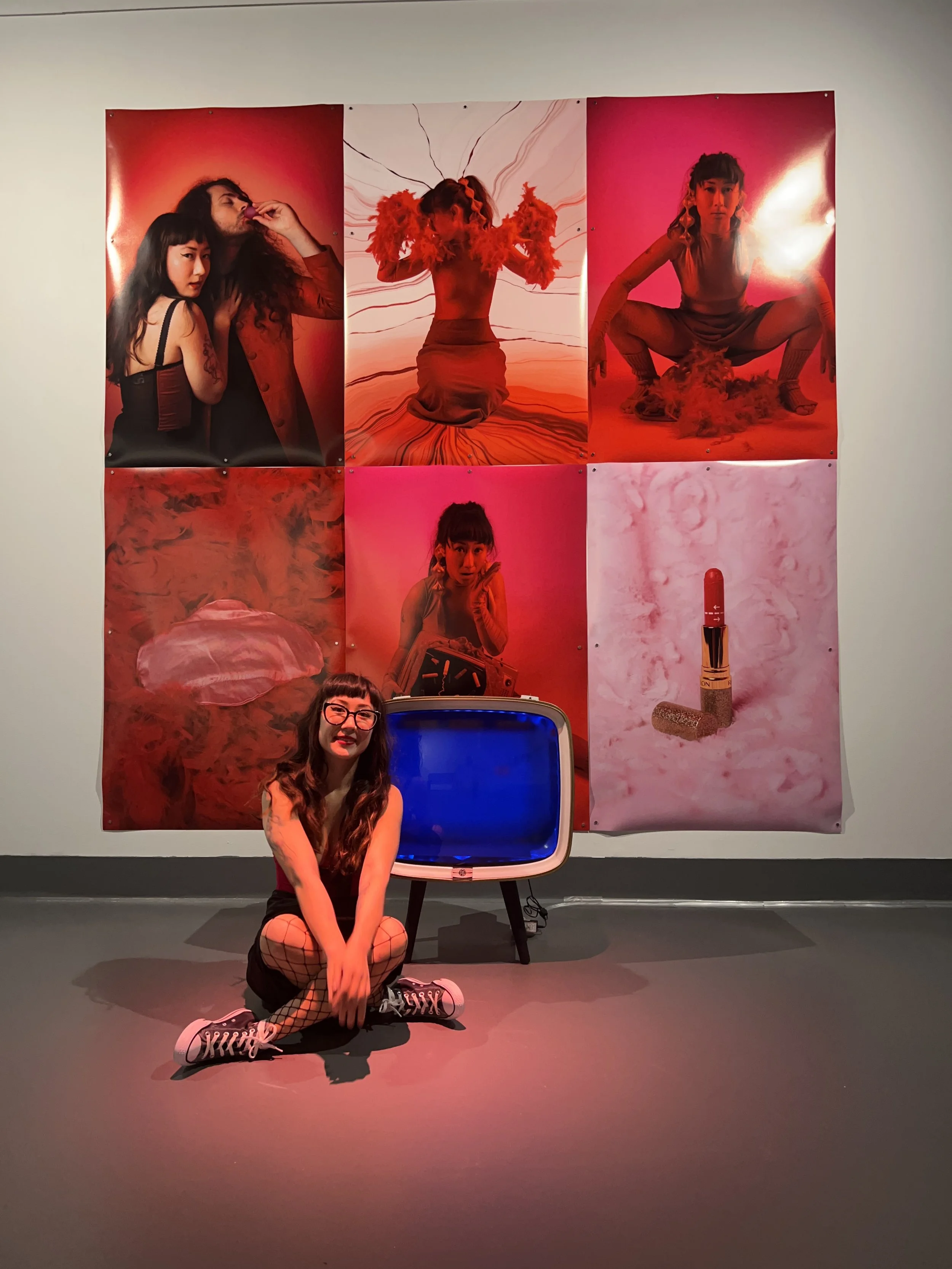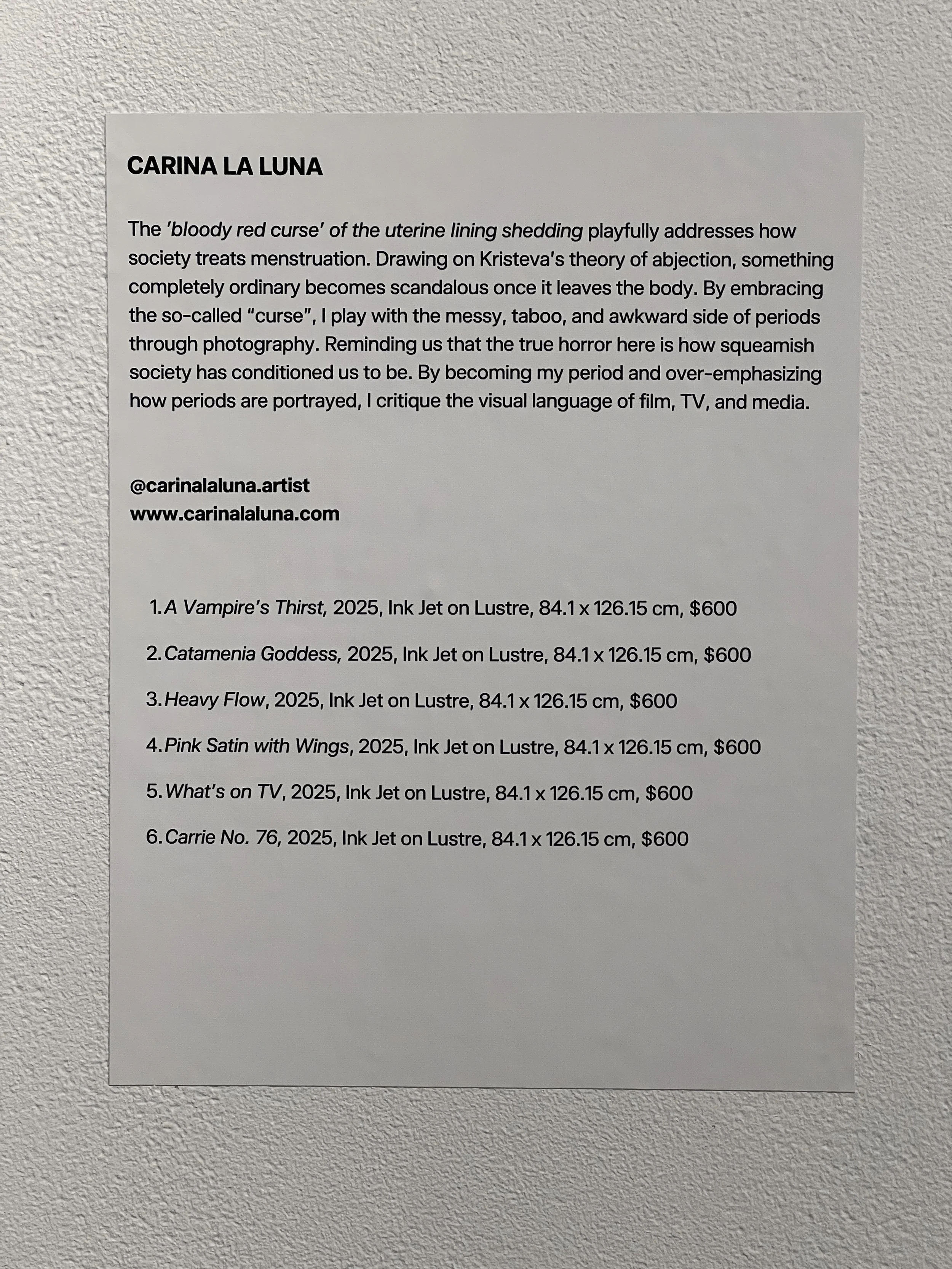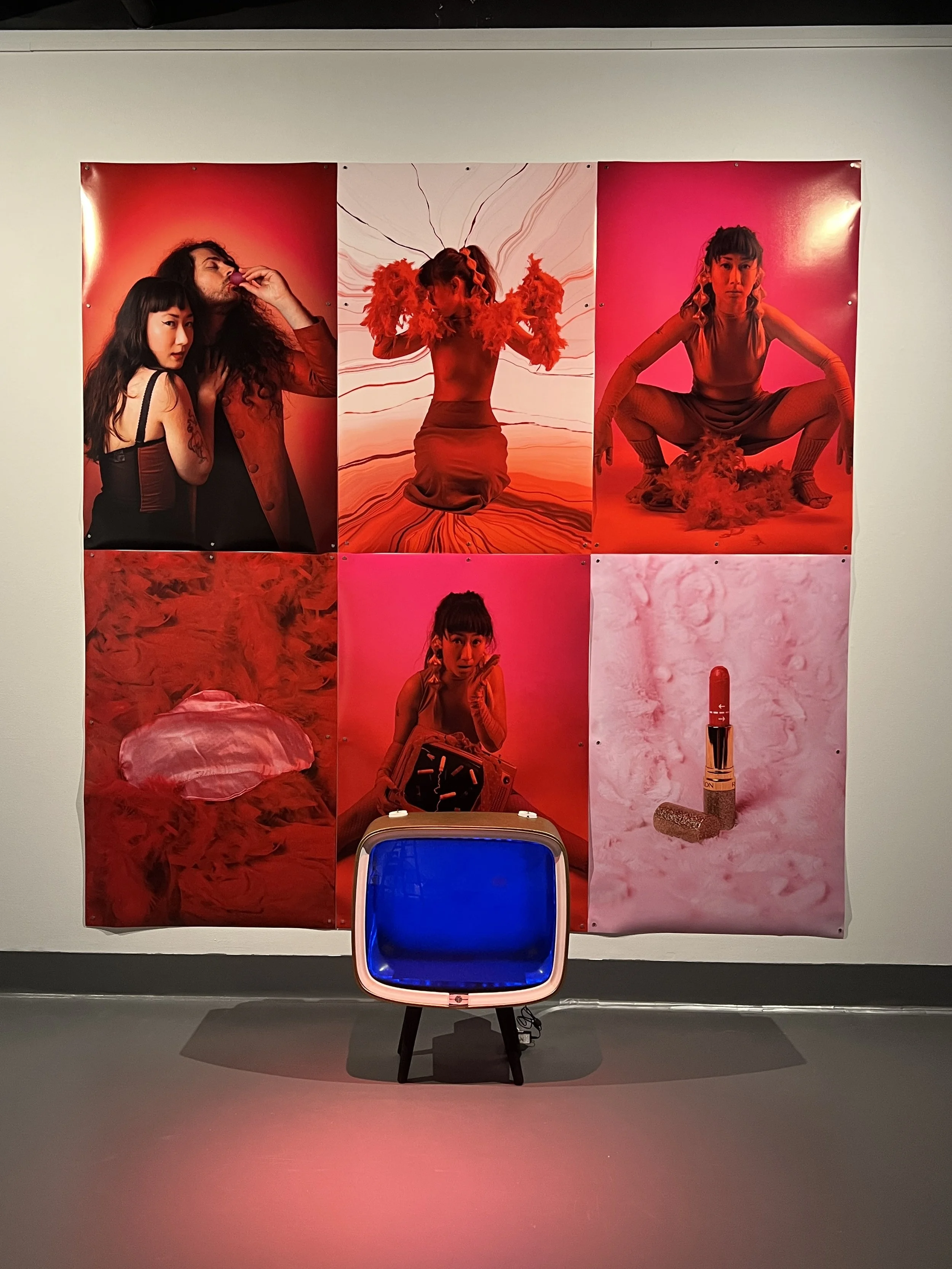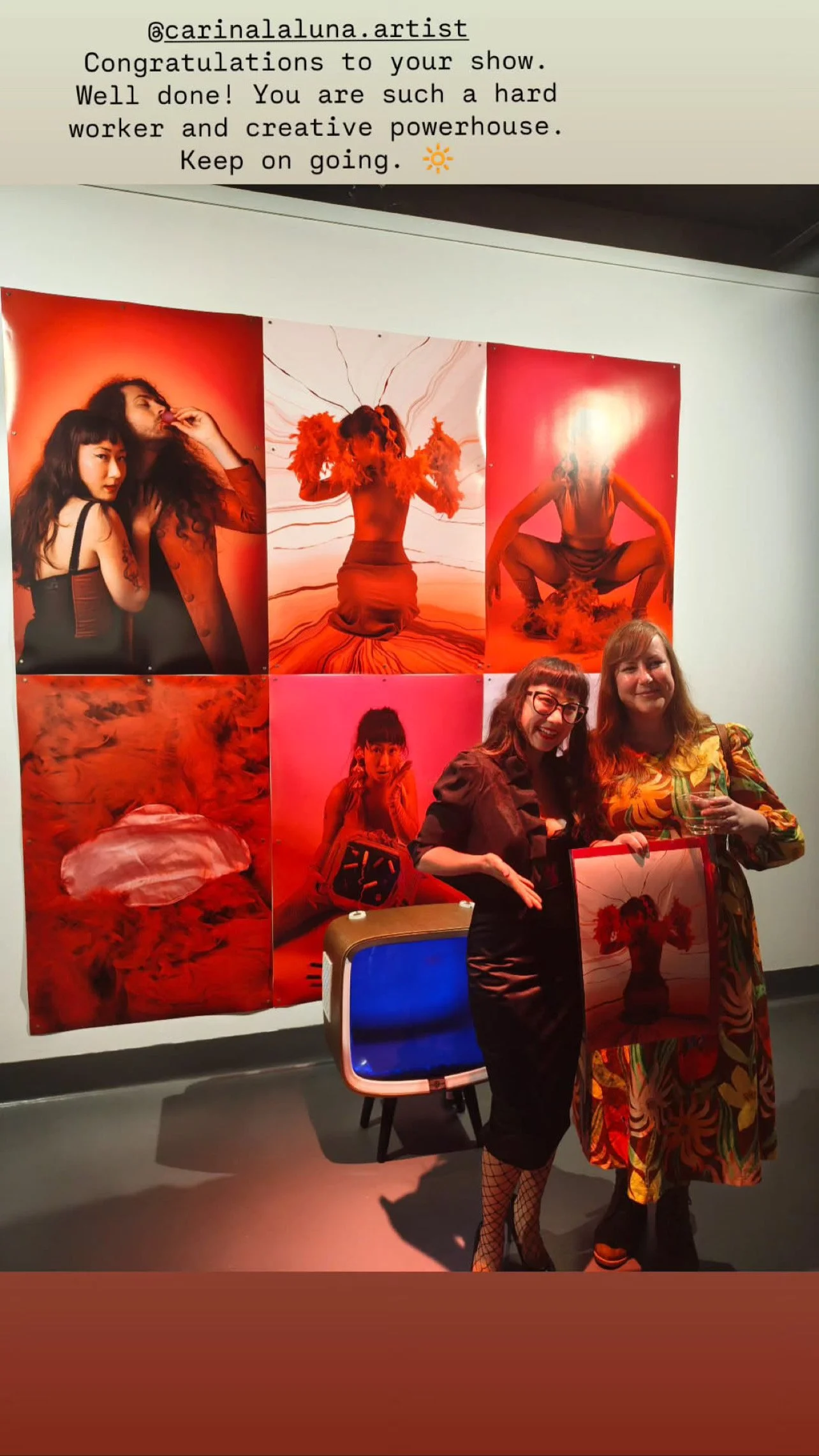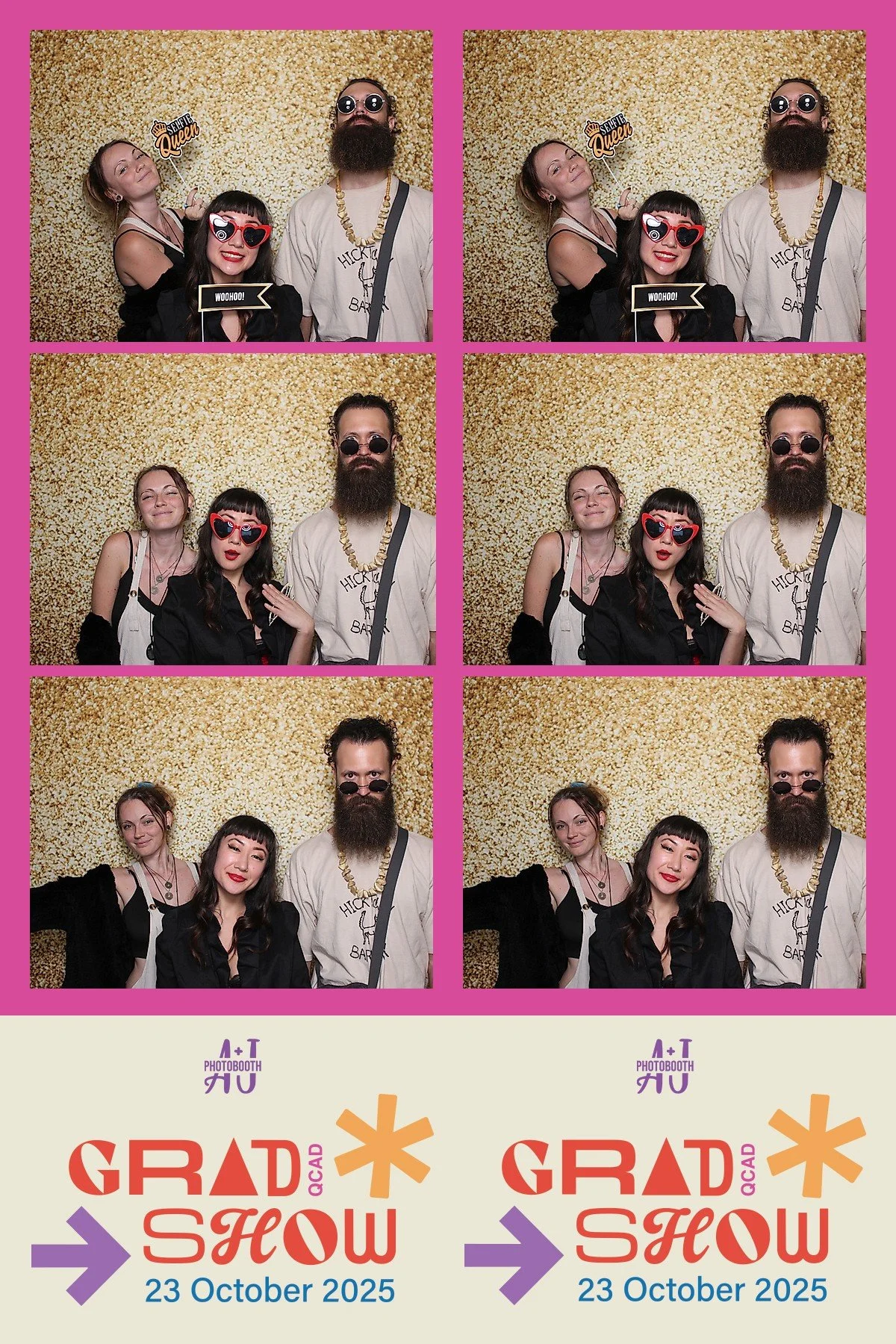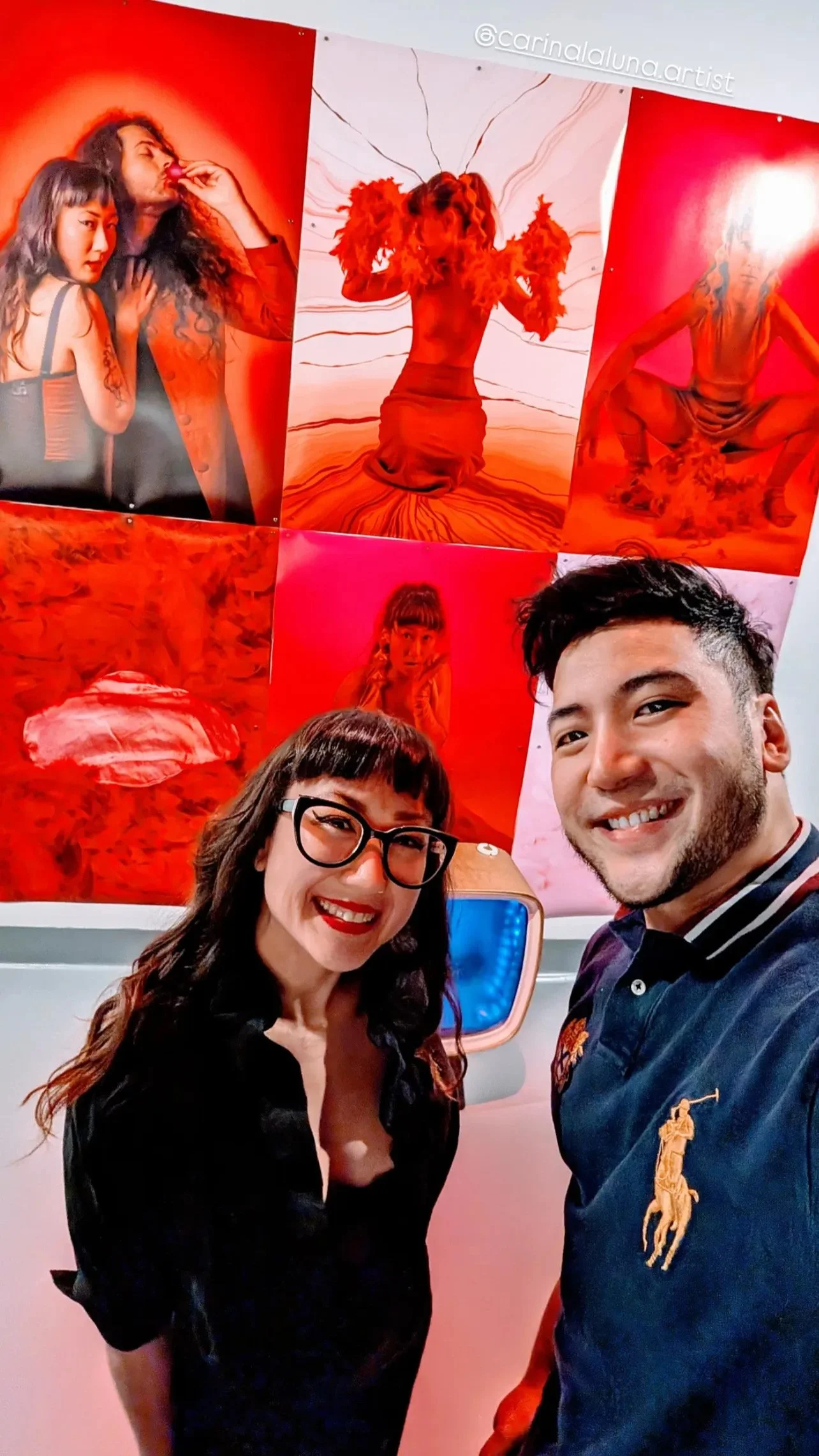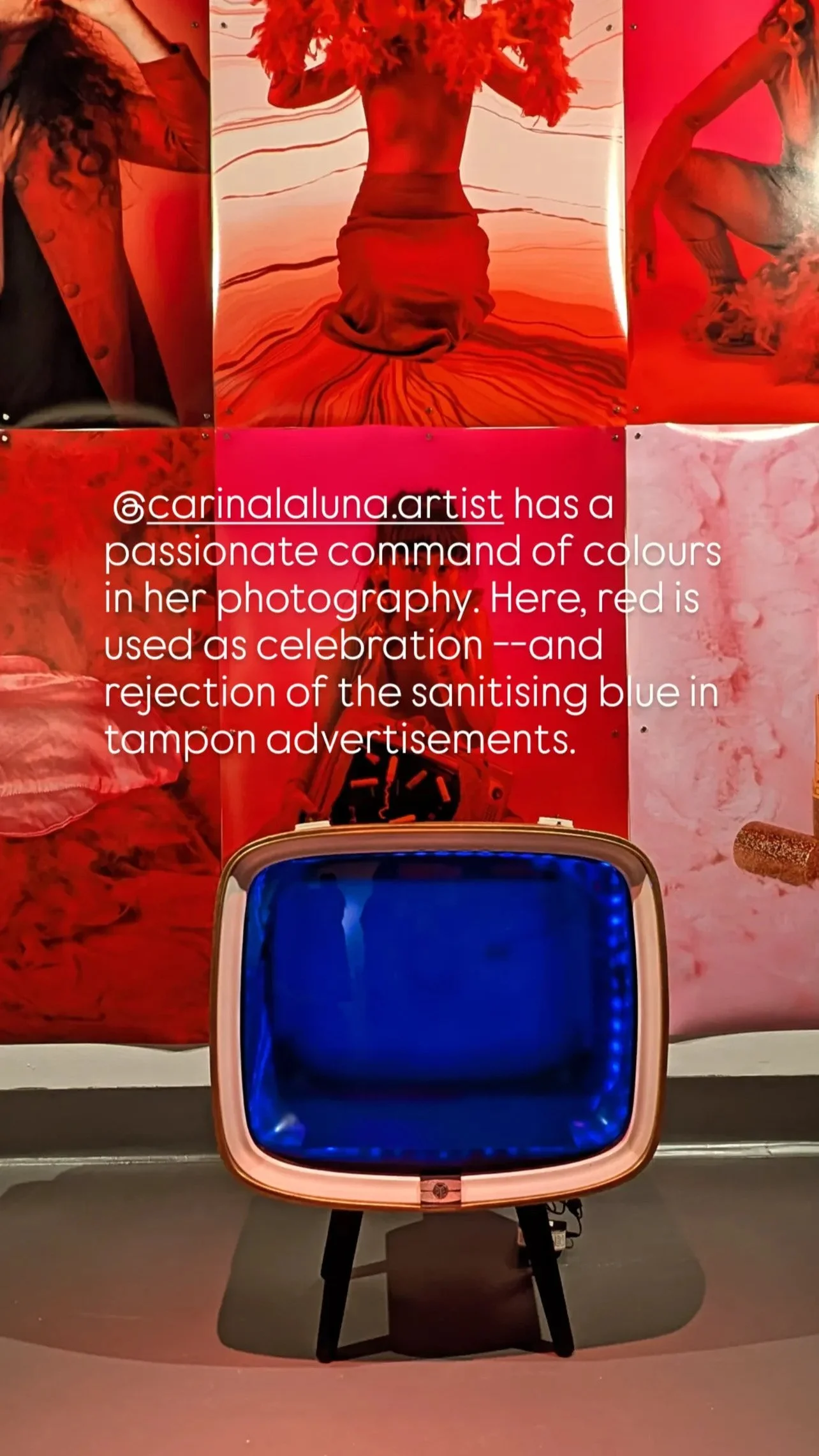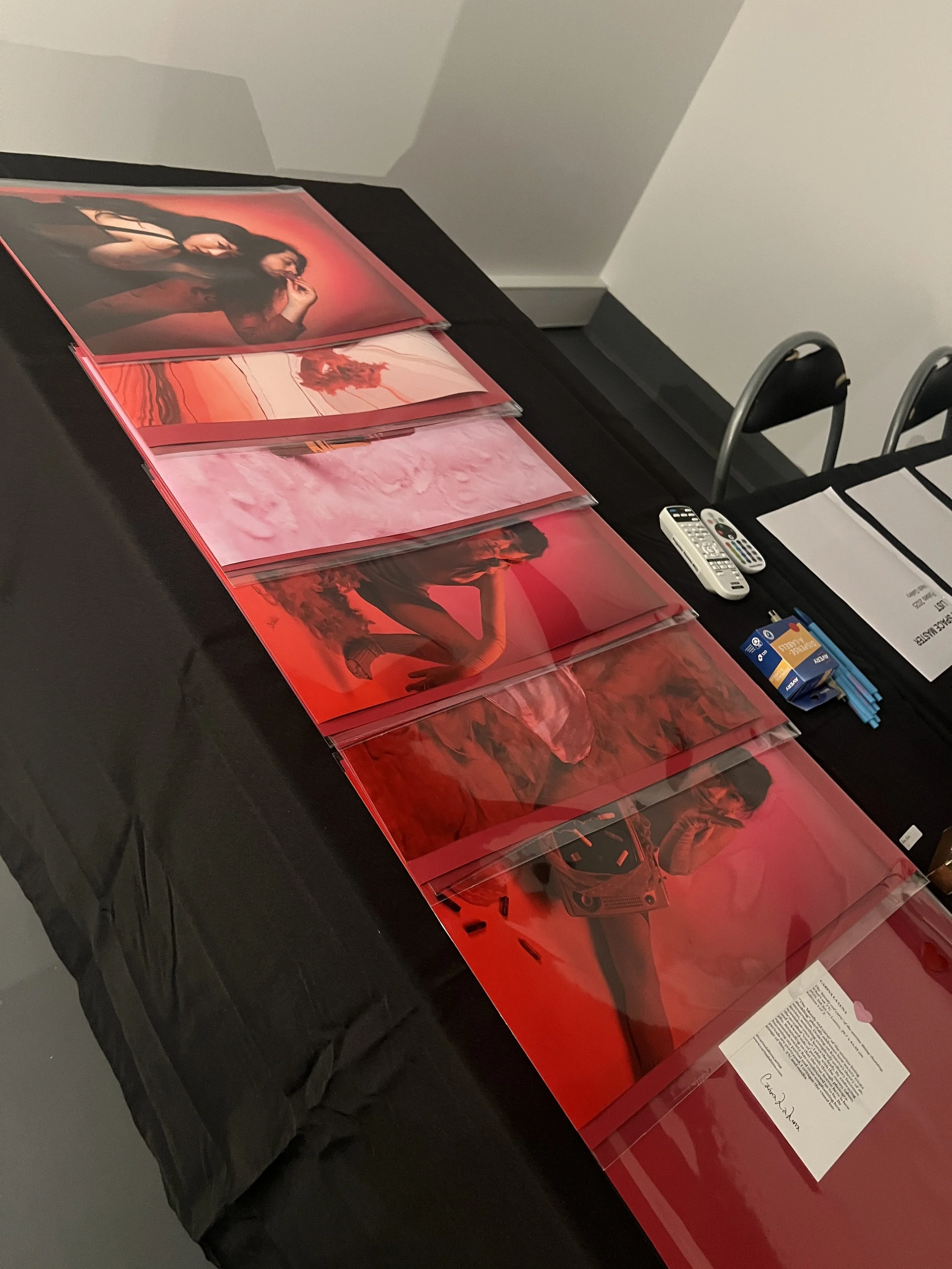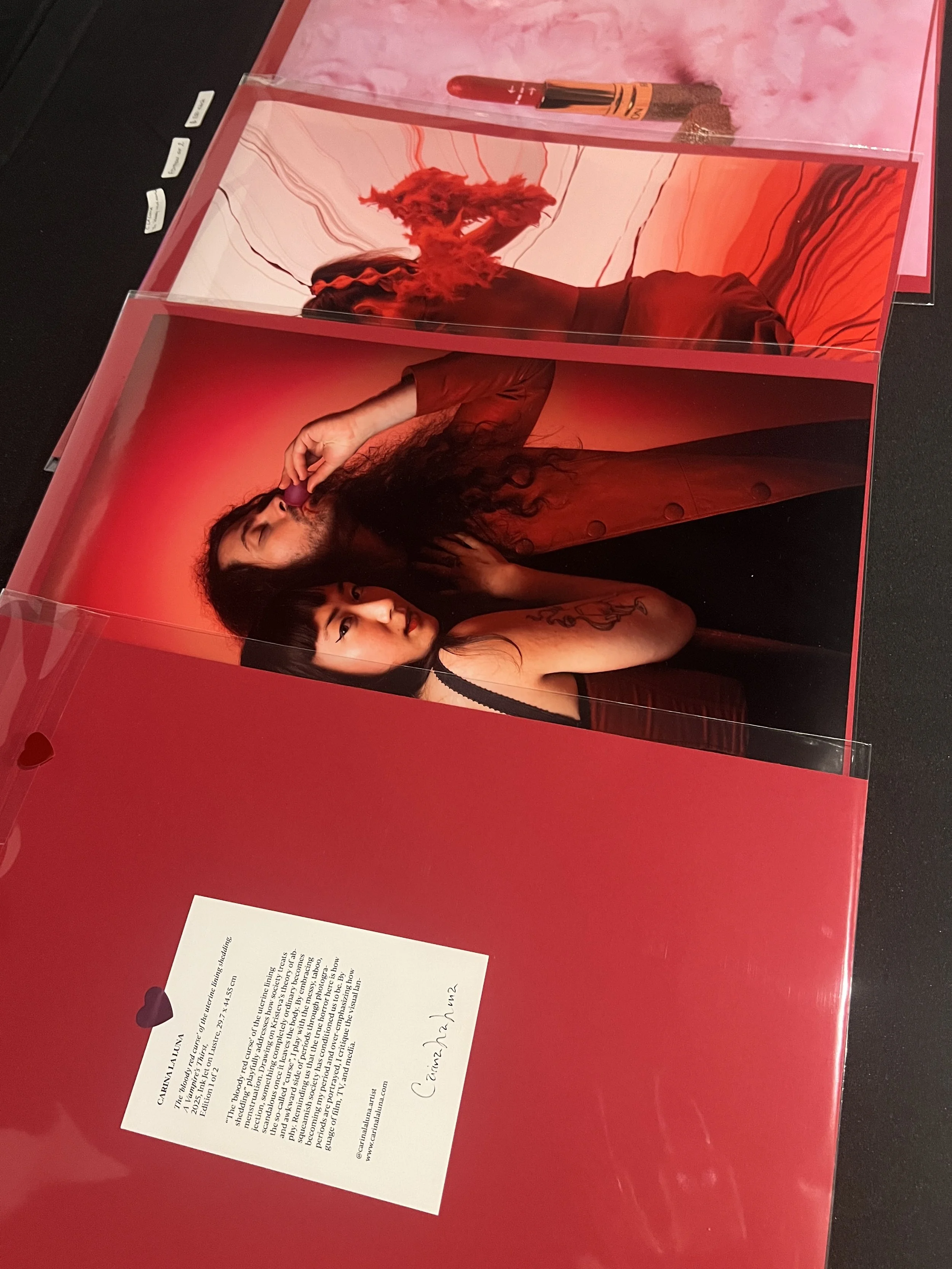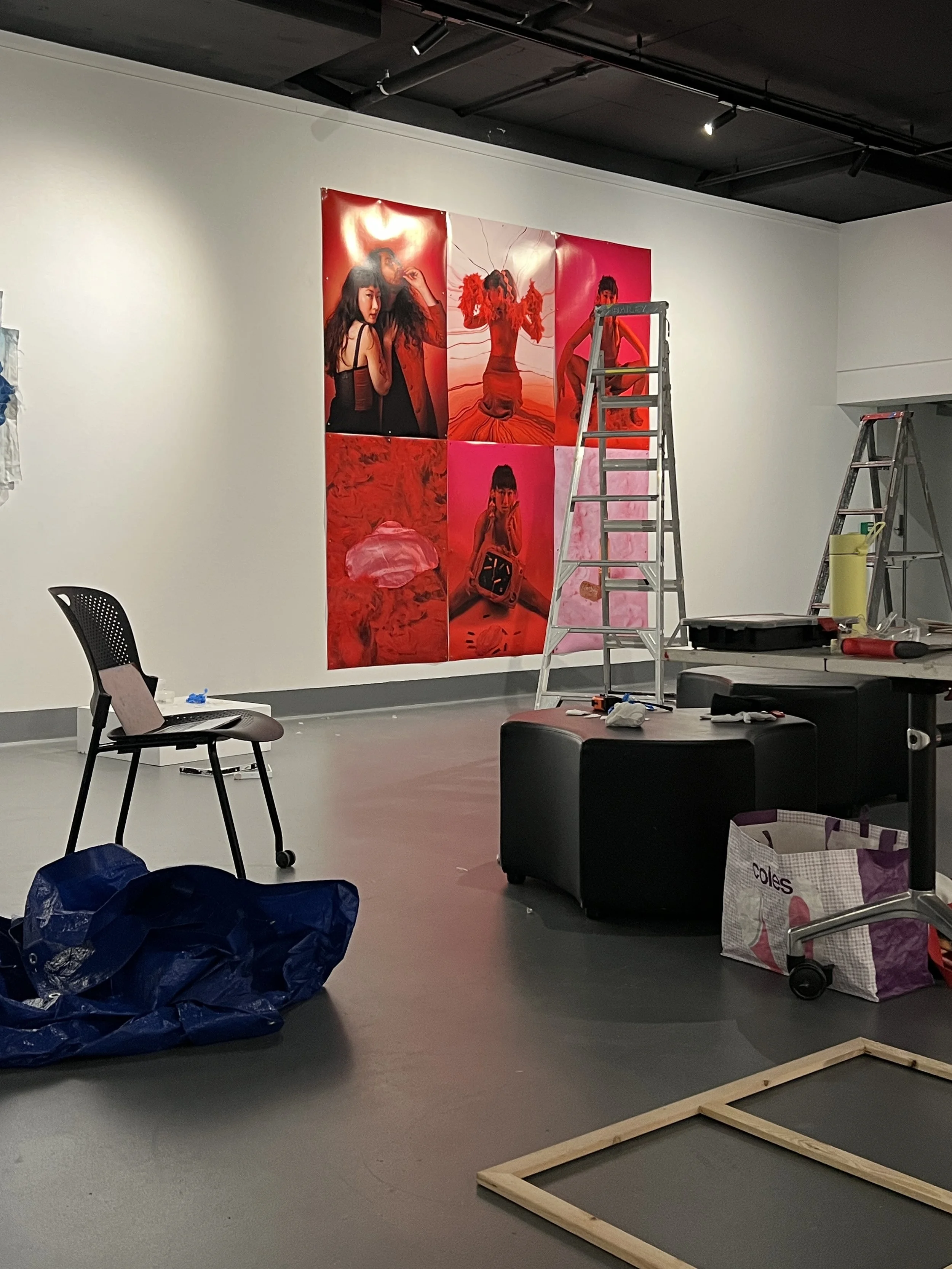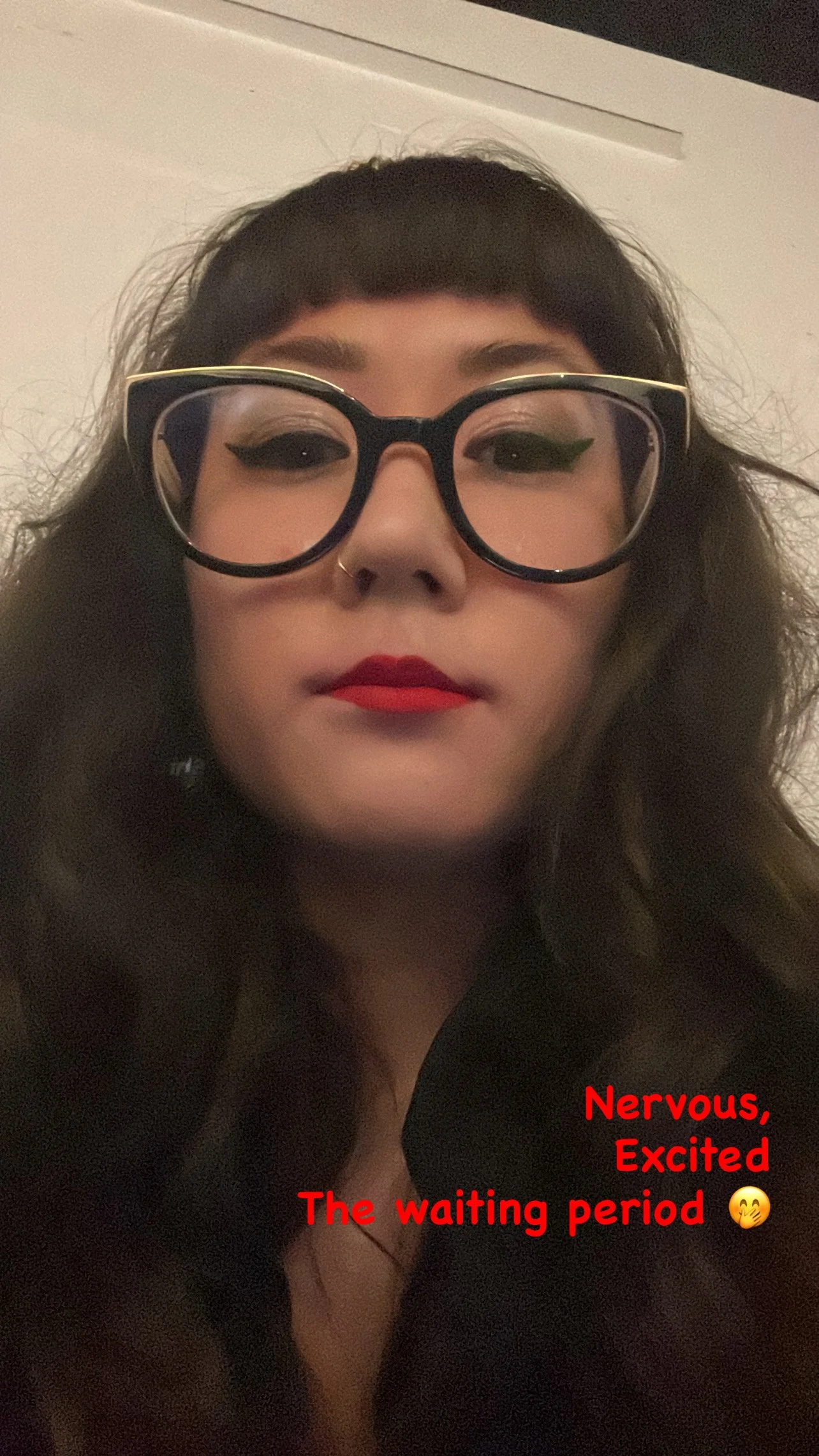The ‘Bloody Red Curse’ of the Uterine Lining Shedding, 2025
Artist Statement
Carina La Luna, The ’bloody red curse’ of the uterine lining shedding, 2025.
Ink Jet on Luster/Semi-Gloss.
“The ’bloody red curse’ of the uterine lining shedding” playfully addresses how society treats menstruation. Drawing on Kristeva’s theory of abjection, something completely ordinary becomes scandalous once it leaves the body. By embracing the so-called “curse”, I play with the messy, taboo, and awkward side of periods through photography. Reminding us that the true horror here is how squeamish society has conditioned us to be. By becoming my period and over-emphasizing how periods are portrayed, I critique the visual language of film, TV, and media.
The ’bloody red curse’ of the uterine lining shedding
1. A Vampire’s Thirst, 2025, Ink Jet on Lustre, 84.1 x 126.15 cm, $600
2. Catamenia Goddess, 2025, Ink Jet on Lustre, 84.1 x 126.15 cm, $600
3. Heavy Flow, 2025, Ink Jet on Lustre, 84.1 x 126.15 cm, $600
4. Pink Satin with Wings, 2025, Ink Jet on Lustre, 84.1 x 126.15 cm, $600
5. What’s on TV, 2025, Ink Jet on Lustre, 84.1 x 126.15 cm, $600
6. Carrie No. 76, 2025, Ink Jet on Lustre, 84.1 x 126.15 cm, $600
—
Smaller prints (29.7 x 44.55 cm) for sale
All of them are an Edition of 2
$250 each
Artist talk
Hey, my name is Carina La Luna, and this is my work, titled “The ‘Bloody Red Curse’ of the Uterine Lining Shedding”, with other subtitles drawn/inspired from Film and TV.
I created this artwork because I am deeply passionate about female sexuality, and menstruation is a big part of it. Even today, menstruation continues to carry taboos, shame, and silence. I initially thought I had a good relationship with my period, but when I started researching and reflecting, I realized there is still shame living in me. Subtle fears and thoughts many women will recognize:
“I have tummy pain instead of period pain.”
“Does my period smell too strong? Will someone notice it?”
“Fear and embarrassment of leaking and bleeding through clothing.”
“I hope I don't offend anyone with my period.” “Does it look weird?”
“omg, there is no bin in this bathroom…where to put it…in my purse?”
These small thoughts reveal a deeper cultural attitude that menstruation should be feared, kept private, or considered gross, even though it's a completely normal part of life. So, I began to wonder where all these thoughts and fears came from. My research led me to Julia Kristeva’s theory of abjection. The theory says that something that is completely ordinary and clean inside the body becomes scandalous and disgusting when it leaves the body. It challenges the illusion of cleanliness and order. When bodily fluids cross the border and separate from us, they remind us that we are alive, messy, and fragile, mortal humans.
In my work, I embrace the abject by becoming my period, as period is a part of me. I use the colour red to celebrate what society rejects. Creating tension between playfulness and abjection to draw people into my work. Menstruation is not only seen as abject but also framed negatively. I wanted to explore where that negativity came from and how it’s reinforced through TV, film, and media. Much of my conceptual work comes from how period is represented (or not represented) in film, TV, and Media. Scholars like Lauren Rosewarner in her book Period in Pop-Culture show how menstruation is portrayed in film, TV, and media, and she found that Menstruation is referenced fewer than 200 times in the history of film up until 2012. Elisabeth Tripp also writes in her book” The Good, the Bad, the Bloody” how media shapes how we feel about menstruation, the images we see on screen (or DON’T’ see on screen) teach us how to feel, behave, what to hide, and what to feel ashamed of and what is considered “too much”. For example, in Australia, up until 2019, they used blue liquid in ads for tampons and pads to represent period blood. Red was too real and disgusting. These visual choices matter as they impact us to believe menstruation needs to be hidden, sanitised, and look a certain way. And when a period appears on screen, it’s often as horror or humiliation.
In Christianity, menstruation has historically been seen as Eve’s curse, something impure that must be purified and controlled. These ideas carry over to cinema. The 1976 film Carrie is the first feature film to show menstruation. However, Carrie’s first period becomes a moment of deep humiliation. Her transformation into a mature woman is portrayed as an uncontrollable monster. The same with Dracula and The Exorcist. Female sexuality and menstruation is intertwined with fear, possession, and evil. In film and TV, we can see how menstruation and female sexuality are treated as something disrupting, monstrous, and dangerous that needs to be purified, controlled, and hidden. Just like Julia Kristeva's theory of abjection, to be controlled and contained. With my images, I wanted to playfully critique the visual language of film, TV, and media by overemphasizing it, while also embracing menstruation. The red, glowing light in my artwork invites the viewer in, turning their skin red and making them part of the abject. But like how media affects the viewer. I have used subtle symbolism, cinematic visuals, and film references, and title names.
The process has been a little tricky, as I have been seeking ways to represent it. how do I present it in a way that is not shocking, in order to engage a broader audience? How can I represent it without evoking too much abjection while also keeping it authentic and conveying my concept regarding how periods are portrayed and challenging the stigma?
I hope my work encourages people to think about how menstruation is portrayed in film and TV, and how it shapes what we feel and think of menstruation and female sexuality in society, and how it affects us as media consumers. By becoming a part of the abject, I hope I can naturalise menstruation as powerful.
Thank you,
Carina La Luna Xoxo
